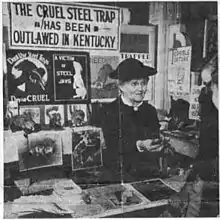Lucy Furman
Lucy S. Furman (June 7, 1870 – August 24, 1958) was an American novelist, short story writer, and animal rights activist. Her fiction was a foundational influence on what would become Appalachian literature.[1]
Lucy Furman | |
|---|---|
 | |
| Born | June 7, 1870 Henderson, Kentucky |
| Died | August 24, 1958 (aged 88) Cranford, New Jersey |
| Occupation | Writer |
| Period | early 20th century |
| Literary movement | Appalachian Literature |
Biography
Lucy Furman was born in Henderson County, Kentucky on June 7, 1869. After her parents’ death early in her life, she moved to Evansville, Indiana. She eventually returned to Kentucky to attend Sayre School in Lexington, graduating in 1885. Upon her graduation, she moved to Shreveport, Louisiana, before moving back to Evansville, where she would live and work independently. In 1894, Century Magazine published some of Furman's short stories. The magazine began to serialize these stories, which were based on her observations of Henderson. Then in 1896, Century collected the short stories into a book titled, Stories of a Sanctified Town.[2]
After this publication, Furman moved to Hindman Settlement School, where she became the school's first director of grounds, gardens, and livestock. During her twenty years' service there, she fictionalized her observations into stories that were published by The Atlantic and Century Magazine, then later collected in best-selling novels such as Mothering on Perilous (1913), Sight to the Blind (1914), The Quare Women (1923), The Glass Window (1924), and The Lonesome Road (1927). For her work as a southern female writer, Furman earned the George Fort Milton Award in 1932.[3]
While known for her writing, Furman was also a leader in the Anti-Steel Trap League of Washington, DC, writing, publishing, and lecturing widely on the subject.[4] In 1934, Furman proposed an anti-steel trap bill to Kentucky's General Assembly.[5] The bill passed and took effect in 1940. In 1953, she retired and moved to Cranford, New Jersey, where she lived with her nephew. She died there on August 25, 1958.[6][7]
Bibliography
- Stories of a Sanctified Town (1896)
- Mothering on Perilous (1913)
- Sight to the Blind (1914)
- The Quare Women (1923)
- The Glass Window (1925)
- The Lonesome Road (1927)
References
- Williams, Cratis D. (1974). "Knott County in the Fiction of Lucy Furman". Appalachian Heritage. 2 (4): 72–86. doi:10.1353/aph.1974.0025. ISSN 1940-5081. S2CID 144990930.
- (30 January 1897). The Lounger, The Critic (New York), pp. 75, 79
- Flora, Joseph M.; MacKethan, Lucinda Hardwick (2001-11-01). The Companion to Southern Literature: Themes, Genres, Places, People, Movements, and Motifs. LSU Press. ISBN 9780807126929.
- Joselit, Jenna Weissman (May 2002). A Perfect Fit: Clothes, Character, and the Promise of America. Macmillan. ISBN 9780805054873.
- "Lucy Furman lobbies against steel trap hunting in KY". Appalachian History. 2017-04-25. Retrieved 2019-02-01.
- (26 August 1958). Miss Lucy Furman (obituary), The New York Times
- Ballard, Sandra L. & Patricia L. Hudson (eds.) Listen Here: Women Writing in Appalachia, pp. 242-43 (2003) (ISBN 978-0-8131-9066-2)